Don’t get me wrong I LOVE going to sushi bars but don’t always want to leave the house, or pay $50+ for sushi. Learning this sushi rice recipe has saved me from spending a ton of extra money at sushi restaurants. It’s not much harder than just making plain white rice really.
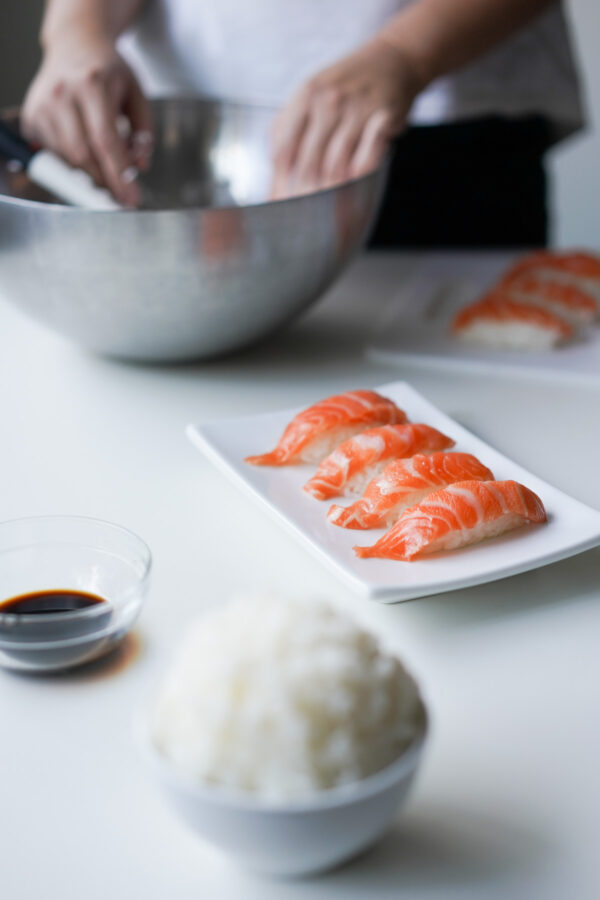
What rice to use for sushi
As long as you have access to sushi grade fish, in a matter of an hour or so you can be well on your way to your own delicious dinner party at home. Some of my fav things to make with this: nigiri, inari sushi, temaki (hand rolls), chirashi bowls, California rolls and spicy tuna rolls.
How to cook the sushi rice
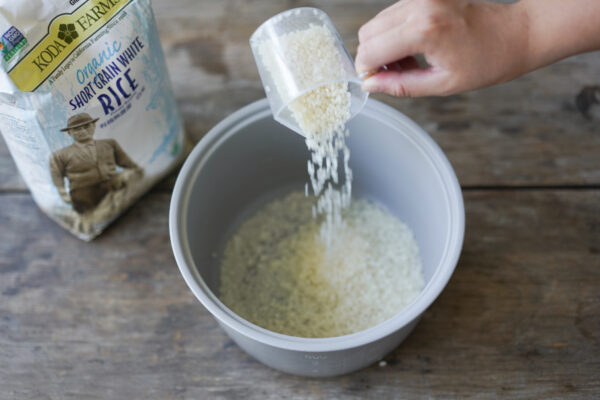
To make sushi rice, first you need to cook the rice the same way you always would. This means any method works: with an electric rice cooker, with an Instant Pot, on the stove, or in the microwave. After it’s cooked, we’ll season it.
I use a relatively affordable electric rice cooker to cook my rice. It provides consistent results, you don’t have to worry about watching it, timing it, or any kind of babysitting. Put in the rice, put in the water, press a button, and perfect rice comes out.
If you have a digital pressure cooker (like the Instant Pot, or any brand), you can cook rice in an Instant Pot for predictable results for rice too!
Of course not everyone eats enough rice to even spend $20-50 (or more) on a rice cooker. If you want to cook it on the stovetop you can too but there may be some trial and error to get the rice perfectly cooked (i.e. you may have to cook a few batches to nail it down).
Sushi rice to water ratio
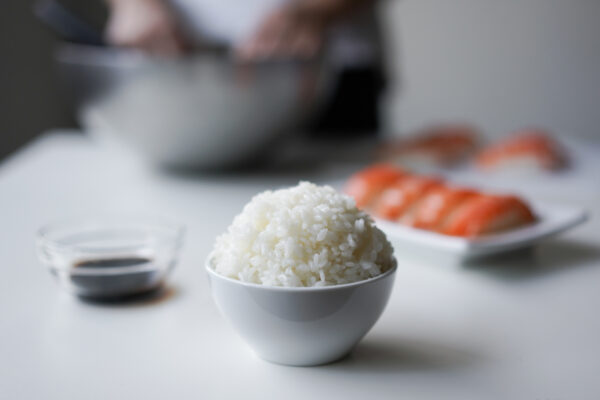
For my sushi rice, using medium or short grain rice, I use a 1:1 sushi rice to water ratio. Please note this does not work for all rice types, other cooking vessels, and it doesn’t always scale up. Check out the other rice cooking posts on my site for tips on those!
For my modestly sized rice cooker, and for medium and short grain rice, this ratio works perfectly when I cook one, two, or three cups of rice.
If you’re cooking it on the stove, or a different vessel, or cooking other types of rice, this ratio does not transfer.
The sushi rice vinegar seasoning
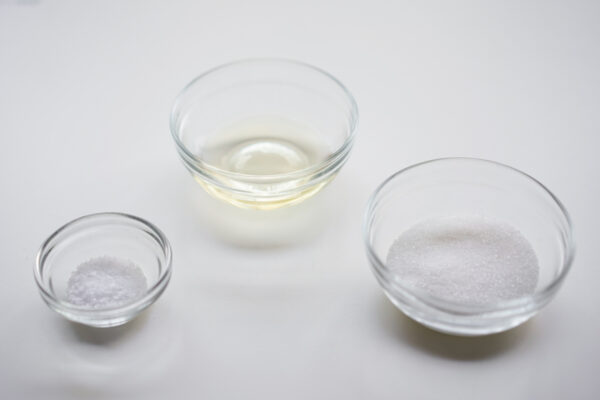
Sushi rice differs in that it’s not just plain steamed rice. You’re going to need to learn how to season sushi rice and luckily, its not too difficult.
Salt, rice vinegar and sugar are the core of what makes sushi rice different than the regular rice we eat daily. You simply just mix these into a single bowl, mix to combine and slightly dissolve, and microwave for ~30 seconds to heat and further dissolve the ingredients.
This is going to smell up your microwave, kitchen, and everyone’s nostrils in the vicinity. Nuking any kind of vinegar will make it smell strong for sure! It will be fine once cooled a bit and mixed into the rice, but straight outta the microwave it will smell. Be warned!
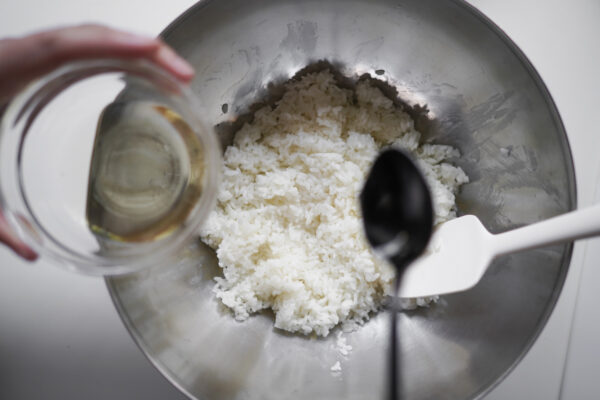
After heating your vinegar mixture you want to incorporate it into the rice. The goal is to evenly coat each grain without smashing all the grains in the process.
I like to add a teaspoon or so at a time, then fold it into the rice. You can ‘slice’ into the rice, then fold a scoopful over, as if trying to work it into a delicate egg white foam or batter.
If you cooked the rice right, it won’t be too mushy or delicate, and obliterating the rice should not be too big a concern.
Where to buy fish for sushi
My favorite place to get sushi grade fish is from Mitsuwa Japanese supermarkets near me. They have a pretty wide selection, and it just feels clean in there.
Korean supermarkets often have sushi grade fish too, although it typically comes sliced already.
If you don’t have any markets near you to pick this up, I’ve actually used online sushi-grade fish delievery service that ships it next day to you with ice packs and the quality is pretty darn good even though everything will cost you more.
How to form sushi rice for nigiri
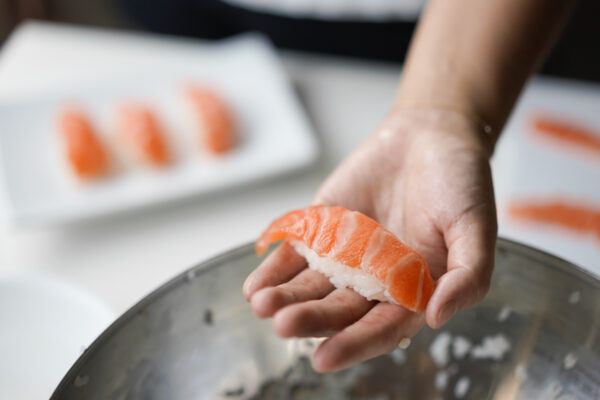
It helps to keep a bowl of cold, filtered water nearby to wet your hands between each rice ball you form for nigiri. A thin coat of water helps prevents the rice from completely sticking to your hands. Keep a towel nearby to wipe your hands as you will eventually have to wipe rice off though.
Just form the rice in your hand roughly the length of your finger, using as much rice as you’d like. Some folks like nigiri to be large enough for two bites, and some prefer much less rice to fish ratios. I like rice, and not just as filler, but you do you!
If you want to avoid the whole nigiri shaping process, it’s super easy to just scoop the rice into a bowl and layer cut fish for chirashi bowl too. You can also make sushi cut rolls or temaki style sushi with this rice. If you want to learn the difference between sushi rolls vs. hand rolls, click on my post.
What type of rice is sushi rice?
Sushi rice is typically Japanese short grain rice, which has a stickier consistency after it’s cooked.
Is there a difference between sushi rice and regular rice? Is jasmine rice sushi rice?
Sushi rice is traditionally Japanese short-grain rice and differs from other types of rice grains due to its sticky consistency. Other types of rice, such as the more popular Jasmine white rice, is a long-grain rice that has a lighter texture and is less sticky than short grain.
I prefer using short-grain rice to make sushi rice because even after adding the vinegar solution to the rice, it will not fall apart because of its sticky texture. This will keep your nigiri and sushi held together well. If you use other types of rice grains, your sushi may fall apart.
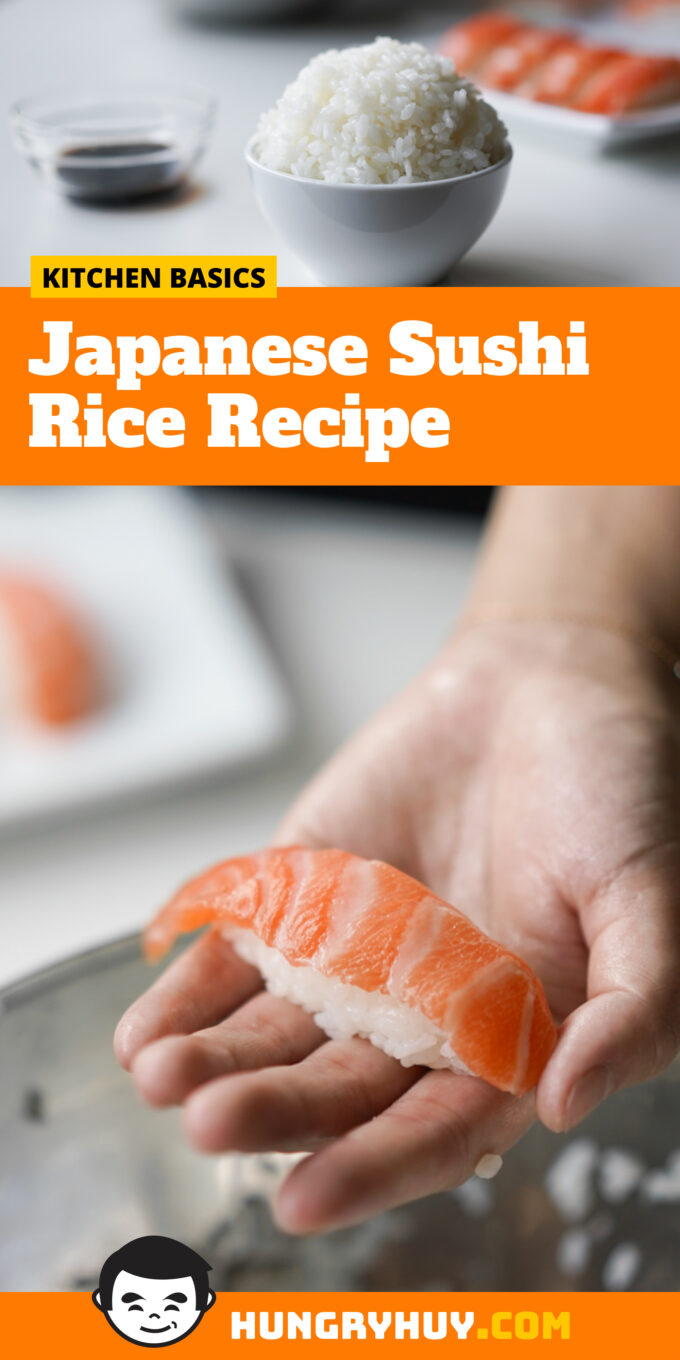
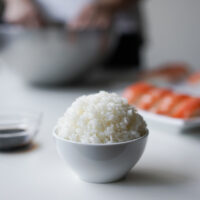
Easy Japanese Sushi Rice
Ingredients
- 2 cups (410 g) short grain rice medium grain works in a pinch too. organic
- tap water for rinsing rice
- 2 cups filtered water
- 2 tbsp (27.8 g) rice vinegar
- 2 tbsp (26.4 g) sugar organic
- 1 tsp (3.5 g) kosher salt if using granulated table salt, you may need less
Instructions
Cooking the rice
- Rinse the rice in a bowl over running tap water. Add about 1-2 cups of water, stir then drain. Do this about two or three times until the water is clear.
- Cook the rice in a rice cooker: Add the rice and water to the rice cooker pot, make sure the rice is flat and level with the bottom of the pot since it can shift during the rinse or transport. Push the start button. After the rice cooker beeps in about 15-20 minutes indicating it's ready, take the pot out and let it cool on the counter for about 10 minutes.
- Or cook the rice on a stovetop: Add rice and water to a medium pot over high heat without a lid and bring to a boil. Once it hits a boil, lower heat to low and cover with a lid. Don't open the lid, don't mix the rice or bother it while it does its thing. After 15 minutes, open the lid and try a grain of rice for doneness. It should be slightly firm, but fluffy, and not hard or chalky inside. If it's too raw, close the lid and add more cook time as needed. Once done let the rice cool for 10 minutes off the heat.
Vinegar mixture
- While your rice is cooling, in a separate microwave safe bowl, combine the rice vinegar, salt, and sugar. Stir to combine and microwave for about 30 seconds. Stir to see if its fully dissolved and microwave another 15 seconds or so until the sugar is dissolved.
Combining rice + vinegar mixture
- Move the warm rice to a large mixing bowl. A wooden one will help by absorbing the water a bit as it cools, but metal or glass works fine too.
- Stir the vinegar mixture before each addition into the bowl of rice, adding 1/2 tbsp at a time as you gently fold the mixture into the rice. The goal is to cover each grain evenly with this mixture, without smashing the grains of rice. Once you've added all the mixture, let the rice cool to almost room temperature before using.






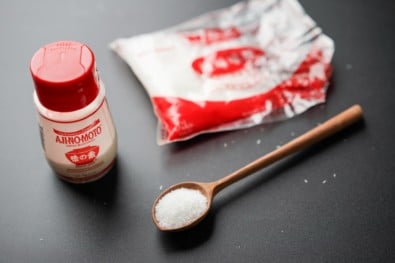



The instructions are so easy and very helpful! I loved how the tbs is in grams; it helps me have a perfect measurement. The rice tastes amazing, and I couldn’t be happier!!
I’m glad you can appreciate the weight measurements Caroline–I definitely prefer using them since there are fewer spoons to wash, and it’s more accurate!